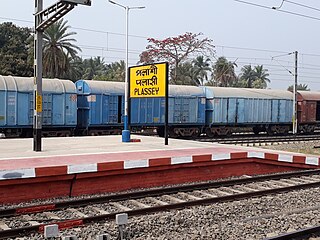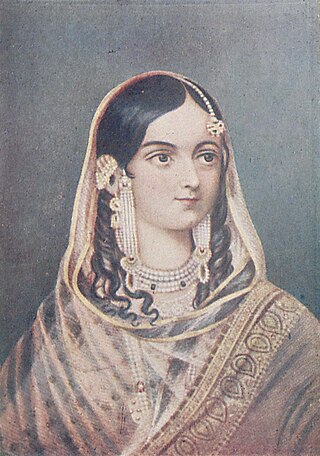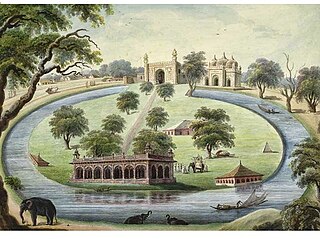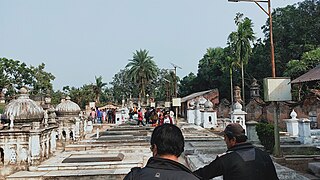
Mir Syed Jafar Ali Khan Mirza Muhammad Siraj-ud-Daulah, commonly known as Siraj-ud-Daulah or Siraj ud-Daula, was the last independent Nawab of Bengal. The end of his reign marked the start of the rule of the East India Company over Bengal and later almost all of the Indian subcontinent.

Murshidabad is a historical city in the Indian state of West Bengal. It is located on the eastern bank of the Bhagirathi River, a distributary of the Ganges. It forms part of the Murshidabad district.

Palashi or Plassey, pronounced[ˈpɔlaʃi], Hindustani pronunciation:[pəˈlaːʃi]) is a town on the east bank of Bhagirathi River, located approximately 50 kilometres north of the city of Krishnanagar in Kaliganj CD Block in the Nadia District of West Bengal, India.

The Nawab of Bengal was the hereditary ruler of Bengal Subah in Mughal India. In the early 18th-century, the Nawab of Bengal was the de facto independent ruler of the three regions of Bengal, Bihar and Orissa which constitute the modern-day sovereign country of Bangladesh and the Indian states of West Bengal, Bihar and Odisha. The Bengal Subah reached its peak during the reign of Nawab Shuja-ud-Din Muhammad Khan. They are often referred to as the Nawab of Bengal, Bihar and Orissa. The Nawabs were based in Murshidabad which was centrally located within Bengal, Bihar, and Odisha. Their chief, a former prime minister, became the first Nawab. The Nawabs continued to issue coins in the name of the Mughal Emperor, but for all practical purposes, the Nawabs governed as independent monarchs. Bengal continued to contribute the largest share of funds to the imperial treasury in Delhi. The Nawabs, backed by bankers such as the Jagat Seth, became the financial backbone of the Mughal court.

Mir Syed Jafar Ali Khan Bahadur, more commonly known as just Mir Jafar, was a commander-in-chief or military general who reigned as the first dependent Nawab of Bengal of the British East India Company. His reign has been considered by many historians as the start of the expansion of British control of the Indian subcontinent in Indian history and a key step in the eventual British domination of vast areas of pre-partition India.

Nashipur is a village in the Murshidabad-Jiaganj CD block in the Lalbag subdivision of Murshidabad district in West Bengal, India.

The Katra Masjid is a former caravanserai, mosque and the tomb of Nawab Murshid Quli Khan. It was built between 1723 and 1724. It is one of the largest caravanserais in the Indian subcontinent. It was built during the 18th century, when the early modern Bengal Subah was a major hub of trade in Eurasia. The Katra Masjid is located in the north eastern side of the city of Murshidabad, in the Indian state of West Bengal. The most striking feature of the structure are the two large corner towers having loopholes for musketry.

Mehar un-Nisa Begum, better known as Ghaseti Begum, was the eldest daughter of Alivardi Khan, Nawab of Bengal, Bihar and Orissa during 1740–1756.

Kathgola Palace is a historical building belonging to the Dugar family at Kathgola in the Murshidabad-Jiaganj CD block of Murshidabad district. It now houses a museum.

Motijhil, also known as Company's Lake due to its association with the East India Company, is a horse-shoe shaped lake in Murshidabad, West Bengal, India. It was created by Nawazish Muhammad Khan, the son-in-law of Nawab Alivardi Khan. He also constructed a precious palatial palace beside this lake which is called the Sang-i-Dalan which is also known as the Motijhil Palace. It is located at the bend of this lake. It was used as the residence of Nawazish and Ghaseti Begum, Nawazish's beloved wife. It is said that after Nawazish died, Ghaseti Begum lived here until Nawab Siraj ud-Daulah took over the palace and seized the residents' in 1756 AD. With this money he built a similar lake with a beautiful palace, Hirajheel, on the opposite side of the Hooghly River. The palace has a lofty gateway, a mosque known as the "Shahamat Jang" and the Kala Masjid and some other buildings which were all built by Nawazish. This palace was built in 1740. As far as etymology is concerned, the palace has been named so as it was built using black basalt pillars which were brought from the ruins of Gaur. Thus, it was given the name of Sang-i-Dalan or the Stone Palace. This palace was then decorated with different varieties of flower plants and precious marbles.

Fauti Mosque is a mosque at Kumarpur in the Murshidabad-Jiaganj CD block in the Lalbag subdivision of Murshidabad district in West Bengal, India. It was built by Nawab Sarfaraz Khan in 1740 AD. The old Fauti Masjid is one of the largest mosques in the town of Kumarpur and Murshidabad district.

The Nizamat Imambara is a Shia Muslim congregation hall (imambara) in Murshidabad, India. It was built in 1740 AD by Nawab Siraj ud-Daulah and rebuilt in 1847 by Nawab Mansur Ali Khan after it was destroyed by the fires of 1842 and 1846. It is frequently mentioned as the largest imambara in the world.

Wasif Manzil was built by Nawab Wasif Ali Mirza Khan under the direction and supervision of Mr. Vivian, officer of the Public Works Department of the Nadia Rivers Division and Surendra Barat, a Bengali engineer. This building, rather palace was used by the Nawab as his residence. The building is extremely close to the Hazarduari Palace. It is built on the Nizamat Fort Campus between the campus's Dakshin Darwaza and the Hazarduari Palace, just opposite the campus's South Zurud Mosque and parallel to the Bhāgirathi-Hooghly River.

The Madina Mosque is a mosque in the Nizamat Fort Campus in Murshidabad, West Bengal, India. There are two Madina mosques in the fort campus, the old one built by Nawab Siraj ud-Daulah during the 18th century.and the new one by Nawab Mansur Ali Khan in 1847.

Jafarganj Cemetery is located in Murshidabad, West Bengal, India.

Khushbagh is the garden-cemetery of the Nawabs of Bengal, situated on the west bank of the Hooghly river, about a mile from its east bank, in the Murshidabad-Jiaganj CD block in Lalbag subdivision of Murshidabad district, West Bengal, India. Khushbagh hosts the graves of the Nawabs of Bengal of the Afshar dynasty and their family members; while Jafarganj Cemetery hosts the graves of the later Nawabs and their families, starting from Mir Jafar, who belonged to the Najafi dynasty. Khushbagh is the resting place of Nawab Siraj ud-Daulah, his wife Lutf-un-nisa, Nawab Alivardi Khan, and his mother, amongst others.

Zinzira Palace, also spelt Jinjira Palace, is a late 17th century Mughal-era palace in Keraniganj, Bangladesh on the southern banks of the Old Ganges or Buriganga River. It was built by Ibrahim Khan II, Bengal's last subedar before Aurangzeb's grandson Azim-ush-Shan took control of the region, as his recreation resort opposing the Bara Katra in the Chowk Bazar neighborhood of Old Dhaka on the other side of the river. The palace is known for the tragic imprisonment of the female members of the Bengal Nawab family following the Battle of Plassey (1757).

Amina Begum was a Bengali aristocrat from the Nawab family of Bengal and mother of Siraj ud-Daulah, the last independent Nawab of Bengal.
Tomb of Azimunissa Begum is located at Azimnagar, in the Murshidabad district.

Jama Masjid is a congregational mosque located at Motijhil, in the historic city of Murshidabad, West Bengal, India.























